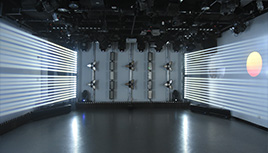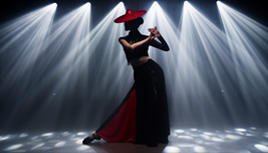How to Integrate Stage Lighting with Other Visual Effects
2025-02-02 Post By: Longmangroup
Stage lighting is one of the most powerful tools in creating an immersive performance experience. When combined effectively with other visual effects, such as projections, video mapping, or pyrotechnics, stage lighting can transform an ordinary production into something extraordinary. However, achieving seamless integration between stage lighting and other visual effects requires thoughtful planning, synchronization, and an understanding of how different elements interact.1. Understanding the Role of Stage Lighting
Stage lighting plays a crucial role in setting the mood, highlighting key moments, and guiding the audience’s attention. With modern LED stage lights, designers have a wide range of options, from color-changing effects to dynamic movement and projection. The first step in integrating lighting with other effects is understanding the purpose of each element. For instance, LED stage lights may be used for subtle changes in atmosphere, while projections or video mapping may serve to enhance the narrative or create immersive environments.
2. Synchronization Between Lighting and Visual Effects
One of the most important aspects of integrating stage lighting with other visual effects is synchronization. Lighting cues should match the timing of other effects, such as video or pyrotechnics, to ensure that they complement rather than clash with each other. This can be achieved by using a lighting control system that allows for precise timing, such as DMX or advanced software-based control systems.
- Example: If you’re using a moving head light to emphasize a key moment in a performance, the stage lighting can be programmed to synchronize with a specific projection or video clip that’s displayed on a background screen. This creates a cohesive experience that feels seamless to the audience.
To maximize the impact of stage lighting, it’s important to consider how lighting and other effects can layer on top of one another. For example, using wash lights and spotlights along with video projections can add a layer of depth to a scene. By controlling the intensity and color temperature of the lighting, you can create visual contrasts that draw attention to certain areas of the stage while allowing other elements to fade into the background.
- Example: A wash light can create a general background glow that sets the mood, while a spotlight can highlight a performer. When combined with video projections or motion effects, these lights create a multi-dimensional scene that feels alive and dynamic.
Color temperature is a key component in both stage lighting and other visual effects. By adjusting the color temperature of your lights, you can enhance the mood set by video projections or animations. For instance, warmer color temperatures (2700K–3200K) can be used to create an intimate or nostalgic atmosphere, while cooler temperatures (5000K–6500K) evoke a futuristic or dramatic feel.
- Example: A LED stage light with a cooler temperature might complement a cold, blue-toned video projection, while a warmer temperature could pair well with a sunset or romantic scene.
Integrating stage lighting with visual effects also requires careful consideration of the physical space. The way lights interact with the space, the size of the stage, and the position of the audience can all impact how the visual effects are perceived. It’s important to use the lighting to shape the environment and work in harmony with the projections or other effects.
- Example: A gobo light can project shapes or patterns onto the stage floor or backdrop, adding an element of texture that complements the movement of the video projections.
Safety should always be a top priority when working with stage lighting and other visual effects. The integration process involves complex technical setups, which require professionals to handle the installation and synchronization. Always ensure that cables, equipment, and power supplies are properly set up and secure to avoid technical failures during a live performance.
Let’s take some various types of stage lights for example below:
1. Moving Head Light
- Integration Method: Moving head lights can be synchronized with video projections, lasers, and pyrotechnics to highlight key moments during a performance. These lights can follow specific movement patterns, emphasizing certain areas of the stage while video projections play in the background.
- Advantages and Performance Enhancements: Moving head lights allow for dynamic changes in lighting direction, which is ideal for creating an immersive experience. By coordinating the light’s movement with other visual effects, such as a video clip or pyrotechnic blast, you can intensify the impact of the moment.
- Example: A moving head light might be used to "follow" a performer, while video projections change on the backdrop, synchronized to enhance the action.
- Integration Method: PAR lights are often used for washes and can be combined with projections and video mapping. The wash effect from PAR lights helps set the atmosphere, while projections add dynamic elements.
- Advantages and Performance Enhancements: The strong color options and even distribution of PAR lights make them excellent for ambient lighting. They provide a uniform background that works well with other visual elements like motion graphics or animated textures.
- Example: PAR lights can be set to a warm color temperature, creating an inviting atmosphere, while a projection of moving clouds adds an element of motion and texture.
- Integration Method: Wash lights are typically used to flood the stage with soft, even lighting. When combined with video projections, they create a seamless blend, enhancing the sense of space and depth.
- Advantages and Performance Enhancements: By adjusting the intensity of the wash light, you can either accentuate the brightness of a projection or allow it to blend naturally into the scene. Wash lights are especially effective when combined with slow-moving background visuals.
- Example: During a performance, the wash light could gradually brighten in intensity, while a video projection moves smoothly across the stage, creating a calming, immersive experience.
- Integration Method: Pixel background lights are used to create vibrant and dynamic backdrops. These can be synchronized with video content to add a layer of interactivity or movement on the stage.
- Advantages and Performance Enhancements: Pixel lights are versatile and can be used to create patterns or animated sequences that move in sync with other stage effects. This can enhance the story being told on stage, adding more visual interest.
- Example: Pixel lights could react to the beat of the music or follow a pattern set by the video projections, creating a stunning visual experience.
- Integration Method: Lasers can be combined with moving head lights and other stage effects to produce sharp, precise beams that interact with projections or other light sources.
- Advantages and Performance Enhancements: Lasers offer a unique visual effect, adding intensity and sharpness to the overall visual experience. When integrated with other lighting effects, they can cut through fog or haze, adding depth and complexity.
- Example: Lasers could be synchronized with pyrotechnics, highlighting specific moments of a performance with their precise beams, while video projections fill in the background.
- Integration Method: Gobo lights project patterns or textures onto surfaces and can be used in combination with video projections to enhance the scene. The gobo can serve as a foundation for projection mapping.
- Advantages and Performance Enhancements: Gobos add texture to the stage, complementing the movement in video projections. They help create an environment by filling the empty spaces with compelling patterns or shapes.
- Example: A gobo might project a forest pattern on the stage floor while a video projection of trees moves in the background, creating a layered, dimensional effect.
- Integration Method: These hybrid lights combine the capabilities of beam, wash, and spotlights, making them perfect for fast-paced shows where different lighting effects are needed in quick succession. They can be synchronized with other visual effects for dynamic transitions.
- Advantages and Performance Enhancements: The flexibility of hybrid lights allows for quick switching between different effects, enhancing the visual complexity of the show. They can add energy during key moments, while the wash effect can soften the overall scene.
- Example: During a concert, a beam light could focus on a solo performer, while the wash light softens the backdrop. Meanwhile, a spot can highlight key performers in synchronized movement with the music.
- Integration Method: Profile and ellipsoidal lights are commonly used for precise spot effects and can be integrated with other visual effects, such as video projections or gobo effects, to direct attention to specific areas of the stage.
- Advantages and Performance Enhancements: These lights offer sharp focus and can be adjusted for intricate lighting designs. They are ideal for detailing, such as projecting a logo or creating tight lighting angles.
- Example: An ellipsoidal light might focus on a performer’s face, while a gobo projects a subtle texture onto the background, allowing for both sharp focus and atmospheric effects.
- Integration Method: Strobe lights are excellent for fast-paced, high-energy effects. They can be integrated with moving lights and pyrotechnics to create dramatic moments or synchronize with intense video content.
- Advantages and Performance Enhancements: The sudden flashes of strobe lights enhance the intensity of action sequences or climactic moments. When synchronized with video effects or other stage lights, they increase the visual impact and create a thrilling experience.
- Example: During a dramatic scene, strobe lights might flash in sync with a quick-paced video projection or pyrotechnic effect, heightening the excitement and engagement of the audience.
Conclusion
Integrating stage lighting with other visual effects allows for an enhanced and immersive experience. Each type of lighting fixture, from moving head lights to strobe lights, plays a critical role in synchronizing with other effects like video projections, lasers, and pyrotechnics. By carefully considering how each light interacts with other visual elements, designers can create a cohesive and unforgettable performance.














